Game Zone: Battle For Wesnoth
by Ryan Smith (Xyus)
"General, I bring grievous news: Oulham and Corkharbor have been sacked by Northerners, the Knalgan war machines have pierced the front lines and are rapidly advancing toward the fortress, and the Necromancer Lords have gained full control over the east. All is not lost, however; the Rebel leader has been slain in battle and his forces scatter before our armies. How should we proceed?"
Such is an average day for the players of the popular open source strategy game, "The Battle for Wesnoth."
Originally created by David White, and now developed by a large group of volunteer contributors, The Battle for Wesnoth is a fantasy tactical strategy game with the design goal of being easy to learn and having simple rules of play while still being challenging for more experienced players.
The objective of the game is usually to "eliminate all foes and be all that is left standing," although this depends on whether a campaign or skirmish map is being played, with different campaign maps having different goals.
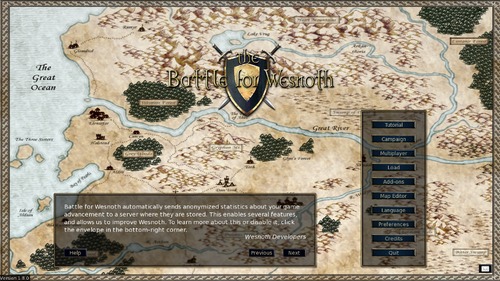
Modes of Play
The game has several modes of play, including Tutorial, Campaign, and Multiplayer modes.
Campaign mode is where the 'stories' of the game takes place. In a campaign, you fulfill objectives in order to advance a plot. The campaigns do not need to be completed in any particular order; all campaigns, from the easiest to the most difficult, are available to play immediately from a clean install. Campaigns are divided into several scenarios that act as chapters of the campaign, with each scenario taking place on its own map and having its own winning and losing conditions.
Multiplayer mode is where, as you may have guessed, you can test your strategies against other players. There are three types of multiplayer modes available: Internet play, LAN, and Hotseat. You can also play single player skirmishes here as well.
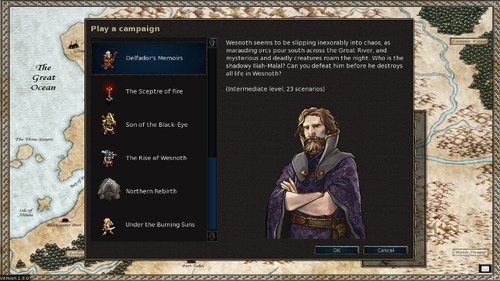
Gameplay
Selecting a campaign from the campaign menu will take you directly into the battle, while selecting a multiplayer/skirmish game will take you to a setup screen.
The units of the game are divided into several factions. The faction you play determines which basic units you will be able to recruit, and will significantly affect your strategy. The factions of the base game are the Loyalists, the Rebels, the Northerners, the Undead, the Knalgan Alliance, and the Drakes. Most campaigns choose your faction for you, but in skirmish and multiplayer games, choosing a faction will be the first strategic choice you will make.
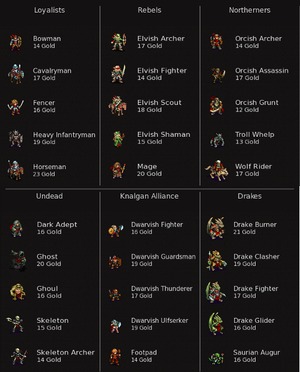
The game is controlled completely by mouse. As with most strategy games, you left click on units to select them, then left click at a target location to move or attack with them. The right mouse button is used for things such as recruiting units and quickly accessing the in-game encyclopedia.
The game itself takes place on a map composed of a number hexagonal tiles. Each tile represents a certain type of terrain, such as a desert or forest. The terrain type of a tile affects how many tiles your unit can move, as well as how much environmental protection they receive. For example, it is more difficult to attack an enemy who is in a forest than in an open plain. Some tiles contain villages, which is the source of gold in the game. Gold is used to recruit units, and is the only resource you have to manage in the game.
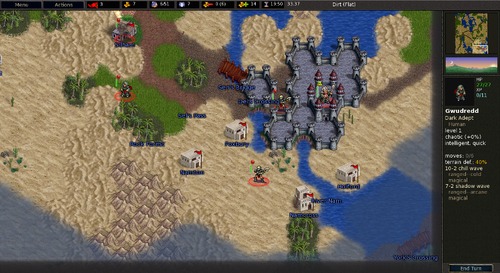
The most important unit in the game is your Leader. The Leader starts out as a higher level unit and is required to recruit units. If you lose your leader, you lose the game. The most common victory condition is destroying all enemy leaders. Aside from these points, the Leader is a normal unit, and can attack and move, with all the advantages and disadvantages of any other unit of his type.
Your leader starts out in a fortress, which acts as your headquarters or capital. Fortresses are composed of a number of 'castle' tiles and a single 'Keep' tile, which can be distinguished from the castle tiles by its unique graphic. The fortress provides considerable defense to your units, and plays a central part in the game. Recruiting new units is only possible when your leader is standing in the Keep tile in the center of a fortress, and is done by right clicking on any space of the fortress and selecting "recruit." When you do this, a list of all units available for recruitment opens, and from this list you pick the unit you want to recruit.
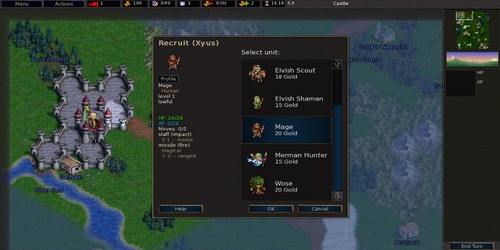
The units themselves are varied, with each unit having a unique set of stats and skills. In addition to having a certain amount of Hit Points (for non-gamers, the amount of damage a unit can take before it is killed) and Movement Points. Every unit has at least one type of attack, weaknesses, and strengths against certain types of attack, an alignment that determines how much damage is done during the night and day, possible bonus abilities, and an amount of battle experience required to advance in level. The tutorial covers these in more detail.
Fighting in this game happens simply by moving one of your units into a space occupied by an enemy unit. The battle window opens, which shows several statistics that may determine how the battle will turn out, as well as a choice between the different attacks the unit possesses.
The attacks you can use in a fight are as varied as the units that use them. During a battle, after an attack has been picked from the menu, units take turns attacking each other. The amount of damage an attack does depends on how many times a unit will use his attack in this fight, how much damage each hit does, and the chance that each hit will connect. Again, these are described in detail in the tutorial.
In addition to normal damage, attacks can also have special abilities, like poisonous attacks that continue to deal damage after a battle, or attacks that can be used by certain Undead units that can turn enemies into zombies under your control.
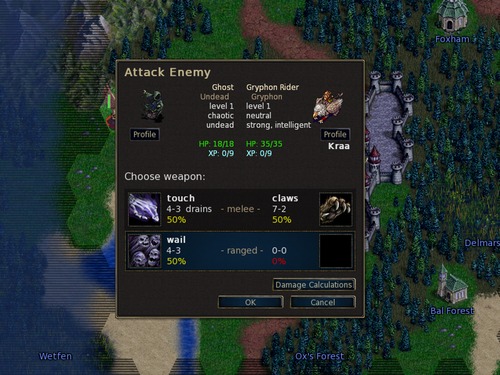
After every battle, especially battles in which an enemy is destroyed, your unit gains experience. After a certain amount of experience is reached, your unit will gain a level, which will cause the unit to change into a more powerful type of unit, and will have a higher amount of HP, and more powerful attacks.
That's about it for game play: Recruit units, capture towns, and fight until you are the last one standing.
Extras
The Battle for Wesnoth is highly moddable. As such, the game has a strong and proficient modding community. From the main menu, you can access both the add-ons repository and a map editor.
The add-ons repository contains all mods available for the version of the game you are using. In here, you can find many interesting add-ons, including new factions, complete with new units, which are usually packaged into groups called 'Eras', new campaigns, multiplayer scenarios and campaigns, and maps for skirmishes and multiplayer games.
The map editor allows you to easily create your own maps from within the game using the terrain tiles and simple paintbrush style tools. These maps are then available to play in skirmishes and multiplayer games.
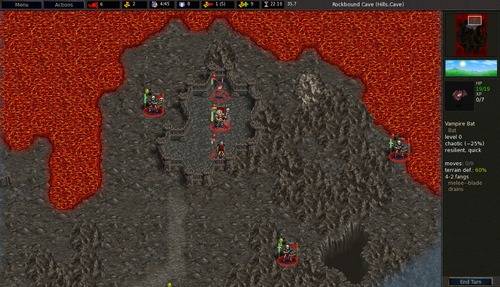
Availability
The Battle for Wesnoth is freely available for many operating systems from the main site, but for PCLinuxOS, you won't have to look far; it is in the PCLOS repositories, under Games/Strategy.
The minimal system requirements are uncertain, but from the FAQ on the site:
"For versions 1.1 and up we recommend a computer with at least 1 GHz and 512 MB RAM if you run KDE or Gnome as Windowmanager"
Synaptic should take care of all of library dependencies.
Hints and Tips
Although The Battle for Wesnoth is a relatively simple strategy game, there are a few things worth knowing.
In addition to gold, villages have another extremely useful property: Leaving a unit on a village and ending the turn will heal that unit upon the start of the next turn. One of the simplest strategies involves having units switch between fighting and healing, prolonging the average lifespan of your units.
Though I only mentioned it when I spoke about unit skills, Alignment plays a significant role in battle. Units can have an Alignment of Lawful, Neutral, or Chaotic. Lawful units are stronger and are more likely to hit during the day, but are weaker and less likely to hit at night. Chaotic units are the exact opposite, and neutral units are totally unaffected by time of day. Use this to your advantage. You do not want to lose your mighty Undead Legion by launching your massive siege in the day.
Some important unit info is covered in the in-game encyclopedia, including weakness and strength against certain types of attacks, and the number of movement points expended when passing over the different terrain tiles. To view a unit's encyclopedia page, right click the unit and select "description".
Your high level units may be powerful, but they are far from immortal. If things look tough, you should pull your most valuable units from the fray, and let them heal. Believe it or not, a level 0 can still defeat a level 3 or 4 if it is sufficiently weakened. More than once, I have sent my most powerful unit to take on more than it could handle, only to have it die in a wave of weak units.
If you are stuck on any of the campaigns, the official site has walk-throughs of all campaigns that come with the game.
Conclusion/My Thoughts
My history with this game goes back a few years, so I am a little biased. Having given that warning, I think this game is very good. Though the setting and campaign stories may not win many awards for originality, that does not detract from the game. The graphics are not bad, in my opinion. But, I get a thrill from text-based games. Judge the graphics from the screen shots. The music lends itself to the theme of the game.
With only one type of resource, no diplomacy, no micromanagement of things like cities, and no research or espionage, the Battle for Wesnoth fulfills its promise of simple game play, adding itself to the "more complex than Chess, less than Civilizations" niche.
Overall, I think strategy gamers, and modders, will enjoy it very much. Others may or may not, depending on their style of play, but I urge all to at least play through the tutorial.
